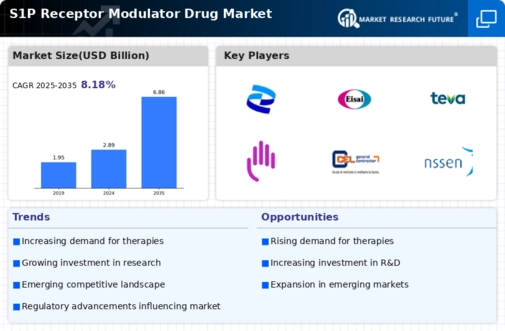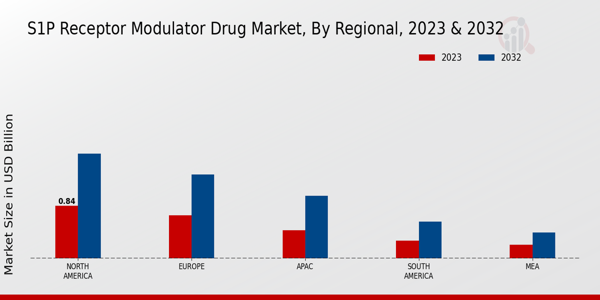Market Growth Projections
The Global S1P Receptor Modulator Drug Market Industry is poised for substantial growth, with projections indicating a market value of 2.89 USD Billion in 2024 and an anticipated increase to 6.86 USD Billion by 2035. This growth trajectory reflects a compound annual growth rate (CAGR) of 8.17% from 2025 to 2035. Such figures underscore the increasing recognition of S1P receptor modulators as vital therapeutic options for managing autoimmune diseases. As research and development efforts continue, the market is likely to see the introduction of new and improved S1P receptor modulators, further driving its expansion.
Rising Awareness and Education
The growing awareness and education surrounding autoimmune diseases and their treatments significantly influence the Global S1P Receptor Modulator Drug Market Industry. Increased patient education initiatives and healthcare provider training enhance understanding of S1P receptor modulators and their benefits. This heightened awareness leads to more patients seeking treatment options, thereby driving market demand. As healthcare systems prioritize patient education, the market for S1P receptor modulators is likely to expand, with more individuals being diagnosed and treated effectively. This trend is expected to contribute to the overall growth of the market.
Advancements in Drug Development
Ongoing advancements in pharmaceutical research and technology contribute significantly to the growth of the Global S1P Receptor Modulator Drug Market Industry. Innovative drug formulations and delivery mechanisms enhance the efficacy and safety profiles of these medications. For instance, recent developments in oral formulations have improved patient compliance and treatment outcomes. This trend is expected to bolster the market, with projections indicating a growth trajectory that could see the market reach 6.86 USD Billion by 2035. As research continues to evolve, the potential for new S1P receptor modulators to enter the market remains promising.
Growing Investment in Biopharmaceuticals
The surge in investment within the biopharmaceutical sector is a crucial driver for the Global S1P Receptor Modulator Drug Market Industry. Increased funding from both public and private sectors facilitates research and development initiatives aimed at discovering novel S1P receptor modulators. This financial backing is essential for advancing clinical trials and bringing new therapies to market. The anticipated compound annual growth rate (CAGR) of 8.17% from 2025 to 2035 underscores the market's potential as investors recognize the therapeutic benefits of S1P modulators. This influx of capital is likely to accelerate innovation and expand treatment options for patients.
Regulatory Support for Innovative Therapies
Regulatory agencies worldwide are increasingly supportive of innovative therapies, which positively impacts the Global S1P Receptor Modulator Drug Market Industry. Streamlined approval processes and incentives for novel drug development encourage pharmaceutical companies to invest in S1P receptor modulators. For example, fast-track designations and priority review vouchers expedite the time it takes for new treatments to reach the market. This regulatory environment fosters a landscape where S1P receptor modulators can thrive, ultimately benefiting patients with unmet medical needs. As these therapies gain approval, the market is expected to witness substantial growth.
Increasing Prevalence of Autoimmune Diseases
The rising incidence of autoimmune diseases globally drives demand for S1P receptor modulators. Conditions such as multiple sclerosis and ulcerative colitis are becoming more prevalent, necessitating effective treatment options. The Global S1P Receptor Modulator Drug Market Industry is responding to this need, with a projected market value of 2.89 USD Billion in 2024. This increase reflects the urgent requirement for innovative therapies that can manage these chronic conditions effectively. As healthcare systems prioritize the treatment of autoimmune disorders, the market for S1P receptor modulators is likely to expand, potentially leading to improved patient outcomes.














